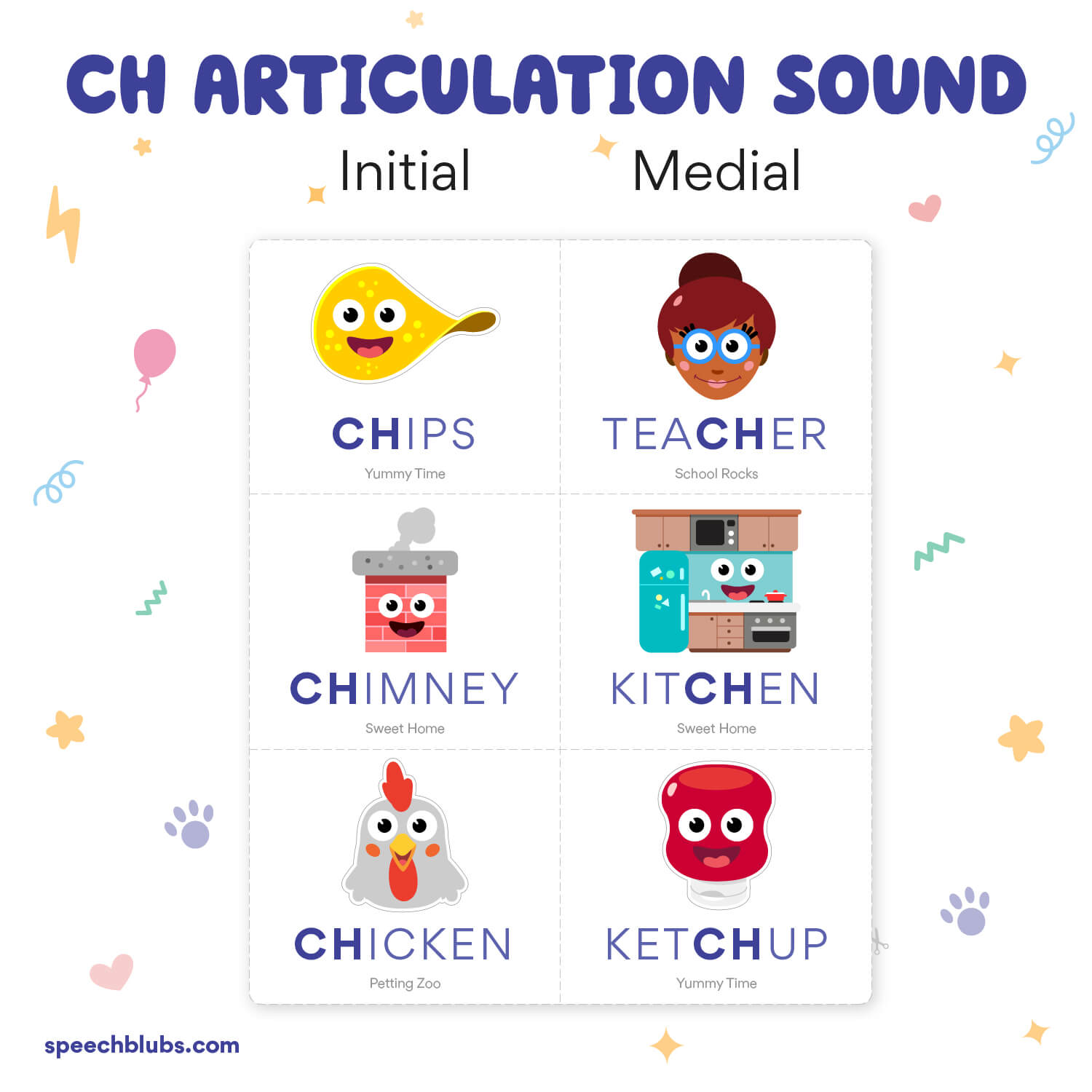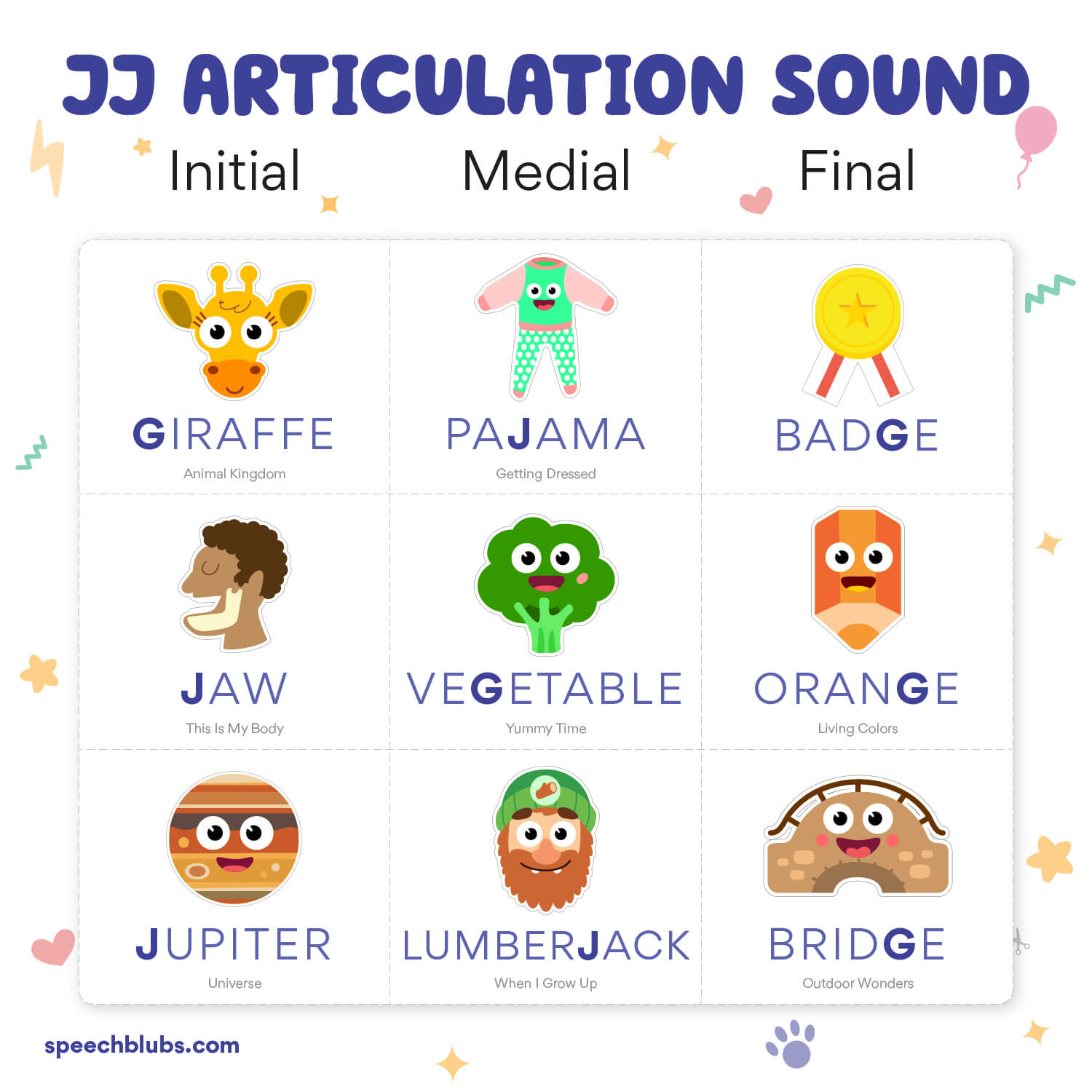JJ and CH Sounds Articulation Therapy: A Guide for Parents
Feb 13, 2022 If your child struggles to produce the J and CH sounds, look no further! Here you'll find some fun activities to practice these sounds with your kid.
The JJ and CH sounds are pairs – which means they are produced in the exact same location, but the JJ sound is produced with your voice “turned on.”
This means that the sound produced comes from both the vibration of the vocal cords and from the movement of air through the mouth. The CH sound is voiceless, which means there is no sound coming out when the sound is produced.
The JJ Sound
To make the sound, put your teeth together and pull the corners of your lips to the middle to form a pucker. The tip of your tongue should rise to touch the top of your mouth just behind your front teeth as air passes through your mouth. The air will temporarily be blocked by your tongue on its way out before being released from your lips.

Children usually produce the JJ sound a bit later, around age 4. Because it’s a more difficult sound, children may not master this sound until around age 7. If by age 7 your child still has not mastered the JJ sound, you will want to talk to your pediatrician about getting a speech and language referral.
When practicing individual sounds with your child, it is important to begin by saying the sound slowly and clearly for your child: “/dʒ/, /dʒ/, /dʒ/” This helps your child to understand what sound you are focusing on and gives them a good example to imitate. Have your child repeat the sound back to you three times.
Gradually, as she begins to master the sound in isolation, add vowels to the sound to form simple syllables, such as “jo, jo, jo,” “jay, jay, jay,” and “jee, jee, jee.” After some practice and a little bit of time, your child will be able to use the /dʒ/ sound in words, phrases, sentences and in conversation. See the whole articulation hierarchy in 7 steps.
Activities for JJ sound
When teaching the JJ sound, I usually give the kids the word, “jump” to practice. At home, you can place some washcloths, bibs or placemats on the floor so they look like lily pads on a pond. Have your kids jump all the way to the end of the “pads,” but they have to say “jump” three times correctly before moving on to the next lily pad. Soon, after some practice, he/she will master the sound!
Boost Your Child’s Speech Development!
Improve language & communication skills with fun learning!

The CH Sound
The CH sound is produced by touching the tip of the tongue to the roof of the mouth to block the passage of air very briefly before releasing it through the mouth.
Say “chicken.” Notice how the tip of your tongue touches the roof of your mouth just behind your front teeth? You might also notice that your lips pucker slightly and that your vocal cords do not vibrate when pronouncing the CH sound. This sound is a voiceless stop consonant. It combines the T and SH sounds (speech buddies).
Children typically begin to articulate the CH sound by the age of three and a half (ASHA). They usually master the sound by the age of seven. If your child exhibits a delay in articulating this sound, seek the services of a speech-language pathologist (SLP). The SLP will likely provide you with homework to do between speech therapy sessions to accelerate your child’s progress.
Activities for CH Sound
The easiest way to work on any sound is through games. If your child loves trains, play with them frequently, giving them plenty of models of “choo-choo” and having them practice after you.
Make a game out of naming as many animals as you can with the CH sound. You and your child could draw these animals as both of you name them. Some examples are cheetahs, chickens, Chihuahuas, and chickadees.
Make a game out of naming everyday objects with the CH sound. Walk through your home with your child and encourage him to name objects like a chair, a couch, a slice of cheese, and the kitchen.
As your child masters the CH sound, encourage him to incorporate CH words in sentences. Make up a silly story about a little boy named Charlie who ate chocolate and had a pet Chihuahua who slept on the couch. Encourage your child to expand on your story.
Show Visual and Audio Cues with the Help of Speech Blubs
Speech Blubs App has multiple activities that you can use to target specific speech sounds. The games are fun and highly engagable so your child won’t even realize that they are working on speech sounds!
To practice making the CH consonant here is the list of sections and words in them that you can practice with your child:
- Petting Zoo: Chicken.
- Ride your Wheels: Train sound.
- Yummy Time: Chips, Chicken.
- School Rocks: Teacher.
- Sweet Home: Chimney, Ketchup.
To practice making the JJ consonant here is the list of sections and words in them that you can practice with your child:
- Wild Animals: Giraffe.
- Living Colors: Orange.
- Outdoor Wonders: Bridge.
- Yummy Time: Vegetable.
- When I grow up: Lumberjack.
- School Rocks: Gym.
- This is my Body: Jaw.
- Universe: Jupiter.
How To Play Articulation Bingo?
- Use the button below to download our Articulation Bingo Board
- Print out the board and give it to your child or cut out the pictures and put them into a bag
- Let your child pick a word from the board / bag
- Find the word in Speech Blubs App and practice it, play with fun filters and watch educational videos
- Your child is a winner when he practices three pictures in a row (across, down, or horizontally) or the entire board
If your child has difficulties with other sounds, here are the articles that can help you with speech therapy and articulation activities ideas:
- Articulation Therapy: An All-in-One Guide for Parents
- B Sound Articulation Therapy
- H Sound Articulation Therapy
- L Sound Articulation Therapy
- Lisp Articulation Therapy
- M Sound Articulation Therapy
- N Sound Articulation Therapy
- NG Sound Articulation Therapy
- R Sound Articulation Therapy
- S Sound Articulation Therapy
- SH Sound Articulation Therapy
- T and D Sounds Articulation Therapy
- W Sound Articulation Therapy


